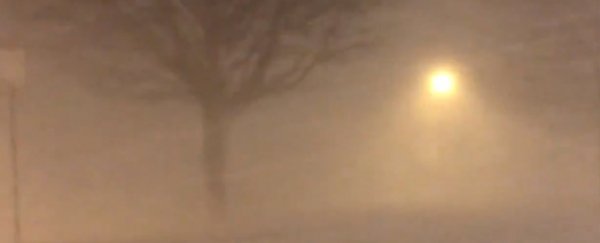New Yorkers looking out the window this afternoon were met with a windy wall of snow.
That was a "snow squall" – a sudden onset of heavy snowfall accompanied by wind gusts. The National Weather Service (NWS) issued a snow-squall warning for residents of parts of New York and New England, advising them to limit travel and stay indoors until it passes.
The warning mentioned "heavy and blowing snow with wind gusts up to 50 miles per hour (80 kilometres per hour) causing whiteout conditions, zero visibility and life-threatening travel conditions."
The threat doesn't seem like it was overstated.
Time lapse of the most intense snow squall I’ve ever seen crossing Hudson River into Manhattan. #ABC7NY #nyc #nywx #njwx #ctwx #snowsquall #snow pic.twitter.com/fw76ilr1Vb
— Jeff Smith (@JeffSmithABC7) January 30, 2019
The NWS suggested people pull over or exit highways before the snow squall arrived, but the warning didn't come soon enough for drivers on Route 222 in Pennsylvania. According to local reports, as many as 40 vehicles crashed during a blinding snow squall before 1:30 pm EST.
Here's what driving conditions in Buffalo, New York, looked like Tuesday evening during a snow squall:
INTENSE SNOW SQUALL hammering Buffalo, NY with whiteout conditions and a taste of the #blizzard conditions to develop by tomorrow afternoon in this area. Very dangerous winter conditions. Good heavens @breakingweather @accuweather #PolarVortex pic.twitter.com/O87Nujl6Ju
— Reed Timmer, PhD (@ReedTimmerUSA) January 30, 2019
The snow squall hit during a week of extreme winter weather. Much of the continental US is experiencing a polar-vortex event that is bringing record cold.
Parts of Minnesota saw thermostats drop to minus 66 degrees Fahrenheit on Tuesday night. The Chicago NWS office reported windchill temperatures in the range of minus 45 to -55 degrees Fahrenheit (7 to -48 degrees Celsius) this morning.
The cold has prompted school and university closures, flight cancellations, and the suspension of mail-delivery services in the Midwest.
This article was originally published by Business Insider.
More from Business Insider:
